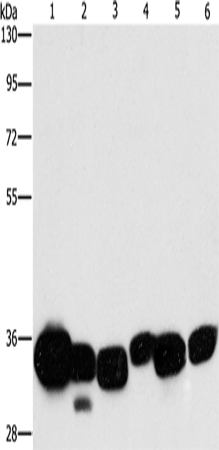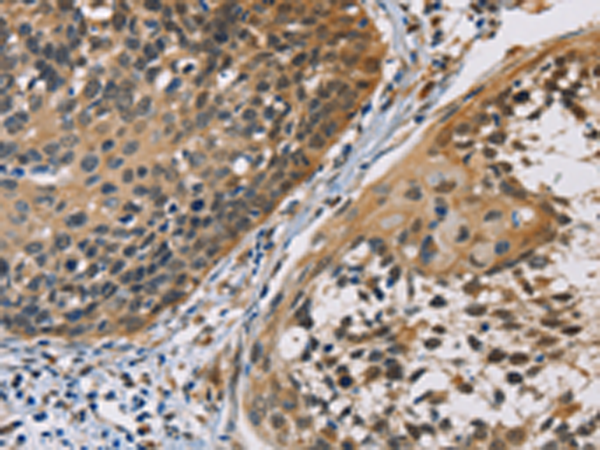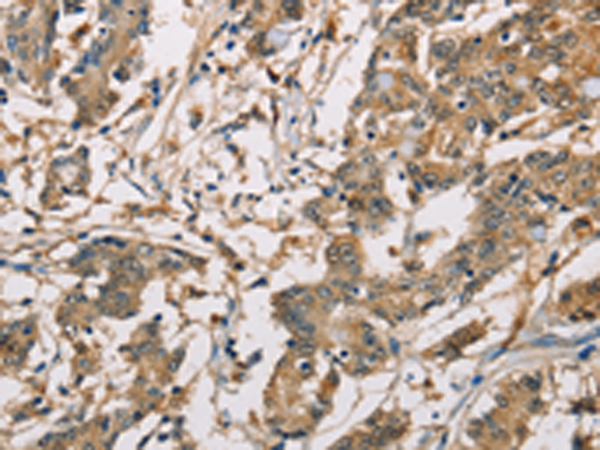


| WB | 咨询技术 | Human,Mouse,Rat |
| IF | 咨询技术 | Human,Mouse,Rat |
| IHC | 1/50-1/200 | Human,Mouse,Rat |
| ICC | 技术咨询 | Human,Mouse,Rat |
| FCM | 咨询技术 | Human,Mouse,Rat |
| Elisa | 1/2000-1/10000 | Human,Mouse,Rat |
| Aliases | CBR; hCBR1; SDR21C1 |
| WB Predicted band size | 30 kDa |
| Host/Isotype | Rabbit IgG |
| Antibody Type | Primary antibody |
| Storage | Store at 4°C short term. Aliquot and store at -20°C long term. Avoid freeze/thaw cycles. |
| Species Reactivity | Human, Mouse, Rat |
| Immunogen | Fusion protein of human CBR1 |
| Formulation | Purified antibody in PBS with 0.05% sodium azide and 50% glycerol. |
+ +
以下是关于CBR1(羰基还原酶1)抗体的3篇文献示例及简要摘要:
---
1. **文献名称**: *"Carbonyl reductase 1 as a novel target of miR-186-5p in colorectal cancer"*
**作者**: Yadav S, et al.
**摘要**: 研究探讨了CBR1在结直肠癌中的表达及调控机制,利用CBR1抗体进行免疫组化分析,发现其高表达与化疗耐药相关,并可能成为潜在治疗靶点。
---
2. **文献名称**: *"Role of carbonyl reductase 1 in oxidative stress response and neuroprotection"*
**作者**: Matsunaga T, et al.
**摘要**: 通过Western blot和免疫荧光技术(使用CBR1抗体),揭示了CBR1在清除活性氧中的关键作用,为神经退行性疾病治疗提供了新方向。
---
3. **文献名称**: *"CBR1 overexpression in breast cancer: Association with poor prognosis and anthracycline resistance"*
**作者**: Hyatt DC, et al.
**摘要**: 利用CBR1抗体检测乳腺癌组织中CBR1表达水平,发现其与蒽环类药物耐药性及患者生存率降低显著相关,提示其作为预后标志物的潜力。
---
(注:以上文献标题和作者为示例性内容,具体研究需以实际发表文献为准。)
The carbonyl reductase 1 (CBR1) antibody is a tool used to detect and study the CBR1 enzyme, a member of the short-chain dehydrogenase/reductase (SDR) superfamily. CBR1 plays a critical role in metabolizing endogenous and exogenous carbonyl compounds, including prostaglandins, steroids, and xenobiotics like the chemotherapeutic agent doxorubicin. It catalyzes the NADPH-dependent reduction of reactive carbonyl groups, influencing drug efficacy, detoxification, and cellular stress responses. CBR1 is ubiquitously expressed, with high levels in the liver, heart, and kidneys, and is implicated in diseases such as cancer, neurodegenerative disorders, and metabolic syndromes.
CBR1 antibodies are widely utilized in research to investigate the enzyme's expression, localization, and function. In cancer studies, they help assess CBR1's role in chemoresistance, as elevated CBR1 activity may reduce the effectiveness of anthracycline drugs. In neurodegenerative contexts, CBR1 antibodies aid in exploring its involvement in detoxifying neurotoxic aldehydes linked to Alzheimer's or Parkinson's disease. Additionally, these antibodies are applied in metabolic disorder research, particularly in conditions like diabetic complications where carbonyl stress is elevated.
Available as monoclonal or polyclonal variants, CBR1 antibodies are optimized for techniques like Western blotting, immunohistochemistry, and ELISA. Their specificity and cross-reactivity (e.g., with rodent homologs) are validated for experimental accuracy. Overall, CBR1 antibodies serve as essential tools for elucidating the enzyme's pathophysiological roles and therapeutic potential.
×